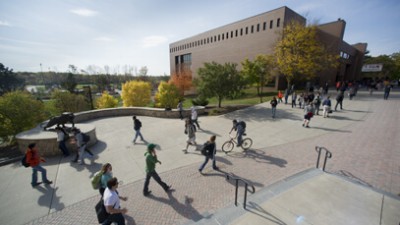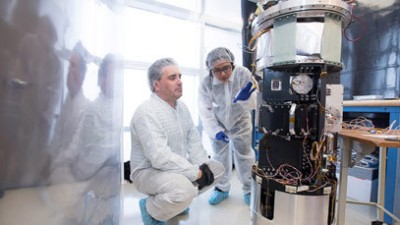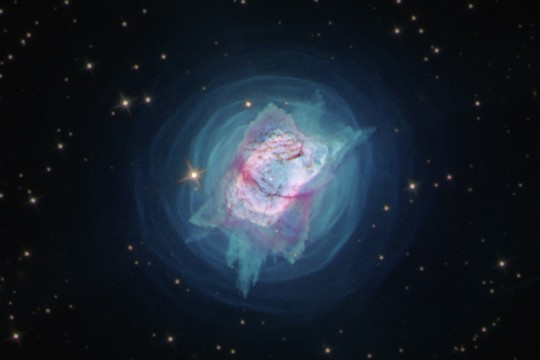News
School of Physics and Astronomy
-
September 14, 2020
![aerial view of buildings on RIT campus.]()
RIT again ranked among the best universities in the nation by U.S. News
RIT has again been recognized as one of the best national universities by U.S. News & World Report, which also cited the university as among the most innovative, with strong undergraduate research opportunities and a highly regarded cooperative learning program.
-
September 9, 2020
![artist's concept illustrating a hierarchical scheme for merging black holes.]()
RIT scientists contribute to the first discovery of an intermediate-mass black hole
The LIGO Scientific Collaboration and the Virgo Collaboration recently announced the discovery of GW190521, the most massive gravitational wave binary observed to date, and Rochester Institute of Technology scientists played an important role in identifying and analyzing the event.
-
June 18, 2020
![x-ray flare from a very young star.]()
X-rays From a Newborn Star Hint at Our Sun's Earliest Days
NASA mentions Joel Kastner, professor in the Chester F. Carlson Center for Imaging Science and School of Physics and Astronomy, and alumnus David Principe '10 Ph.D. (astrophysical science and technology) for being part of a team that observed an X-ray flare from a very young star using NASA's Chandra X-ray Observatory.
-
June 18, 2020
![Hubble image of gas and dust ejected from a star.]()
Hubble Provides Holistic View of Stars Gone Haywire
NASA features Joel Kastner, a professor in RIT’s Chester F. Carlson Center for Imaging Science and School of Physics and Astronomy, and astrophysical science and technology Ph.D. students Jesse Bublitz and Paula Moraga on their latest Hubble telescope observations.
-
April 2, 2020
![looking up side of brick building at sunny sky.]()
‘U.S. News’ rankings highlight RIT graduate programs
RIT graduate programs are among the best in the nation, according to the U.S. News annual statistical survey of graduate programs. RIT master’s degree programs in engineering, business and fine arts feature in the U.S. News & World Report 2021 edition of Best Graduate Schools, released in March, including the first specialty ranking of the university’s business analytics master’s program.
-
February 10, 2020
![Artist's conception of a massive planet orbiting a cool, young star.]()
RIT scientists discover the nearest-known ‘baby giant planet’
Scientists from RIT have discovered a newborn massive planet closer to Earth than any other of similarly young age found to date. The baby giant planet lies only about 330 light years from our solar system. The discovery, published in the Research Notes of the American Astronomical Society, provides researchers an exciting new way to study how gas giants form.
-
December 12, 2019
![large and small satellite dishes.]()
RIT and IAR observe pulsars for the first time from South America
A team from RIT and the Instituto Argentino de Radioastronomía (IAR) upgraded two radio telescopes in Argentina that lay dormant for 15 years in order to study pulsars, rapidly rotating neutron stars with intense magnetic fields that emit notably in radio wavelengths. The project is outlined in a new paper published in Astronomy and Astrophysics.
-
November 20, 2019
![Yellow and purple illustration of black holes colliding.]()
Baby Black Holes May be Orbiting Supermassive Black Holes
Futurism cites research by Richard O’Shaughnessy, assistant professor in the School of Mathematical Sciences.
-
November 18, 2019
![Two researchers wearing cleansuits work on detector equipment.]()
Researchers prepare rocket for launch
A team of RIT researchers is helping launch an experiment above the atmosphere to better understand extragalactic background light, which traces the history of galaxies back to the formation of the first stars in the universe.
-
November 8, 2019
![Simulation of an accretion disk surrounding a supermassive black hole.]()
New study suggests ‘Pac-Man-like’ mergers could explain massive, spinning black holes
Scientists have reported detecting gravitational waves from 10 black hole mergers to date, but they are still trying to explain the origins of those mergers. The largest merger detected so far seems to have defied previous models because it has a higher spin and mass than the range thought possible. A group of researchers, including RIT Assistant Professor Richard O’Shaughnessy, has created simulations that could explain how the merger happened.
-
October 25, 2019
![An artists rendering of a blackhole, with red and orange waves.]()
Shedding light on black holes
The Christian Science Monitor talks to Manuela Campanelli, professor and director of the Center for Computational Relativity and Gravitation.
-
October 21, 2019
![Moumita Das in lobby of College of Science.]()
RIT researcher receives NSF grant to help build a synthetic neuron and neural network
Researchers from RIT and six other universities are teaming up to build synthetic neurons and a programmable network of such neurons in an effort to better understand the rules of life. The project is part of the National Science Foundation’s “Big Ideas” initiative— 10 bold, long-term research and process ideas that identify areas for future investment at the frontiers of science and engineering.
















